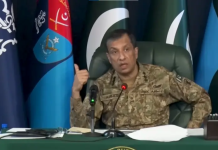ISLAMABAD: The armed forces are likely to be allocated Rs1.453 trillion in the budget for the next fiscal year, which would be about Rs83 billion higher than the outgoing year’s allocation of Rs 1.37tr, an increase of almost six per cent.
Defence spending often comes under scrutiny at the time of the announcement of the annual budget when allocations for various sectors are earmarked.
This year a Rs136bn raise was expected after taking into account an average of 11.3pc inflation for the outgoing year. Therefore, in number terms, the armed forces would be getting about Rs53bn less than what they say was needed for coping with inflation.
The impact of the defence spending is measured in two ways — the share of the defence services in the overall budget pie and as a percentage of the GDP.
The share in the total outlay explains how much money is going to the armed forces. Meanwhile, calculating the defence budget as a percentage of the GDP indicates its burden on the national economy.
The defence budget, going by these figures, would be about 16pc of total outlay — much similar to the outgoing year. But, in terms of GDP, its share would go down from 2.54pc in the outgoing year to 2.2pc in the next fiscal year.
The increased amount, the defence source says, will be consumed mostly by the allocation for employees-related expenses, salaries and allowances of servicemen.
Other heads of the budget include civil works, which caters for the military infrastructure development and repairs; physical assets that relate to local purchases of arms and ammunition and some imports and the related costs; and operating expenses, which cover costs incurred on transport, ration, training and treatment.
The source said that the spending per soldier is about Rs2.65 million per annum, which is not even one-third of what India spends.
The source, meanwhile, said that armed forces and their welfare entities paid Rs935bn in taxes in the outgoing year.
They further said that Army saved and returned Rs500m to the government from Covid allocation and $16.9m against procurements.

















